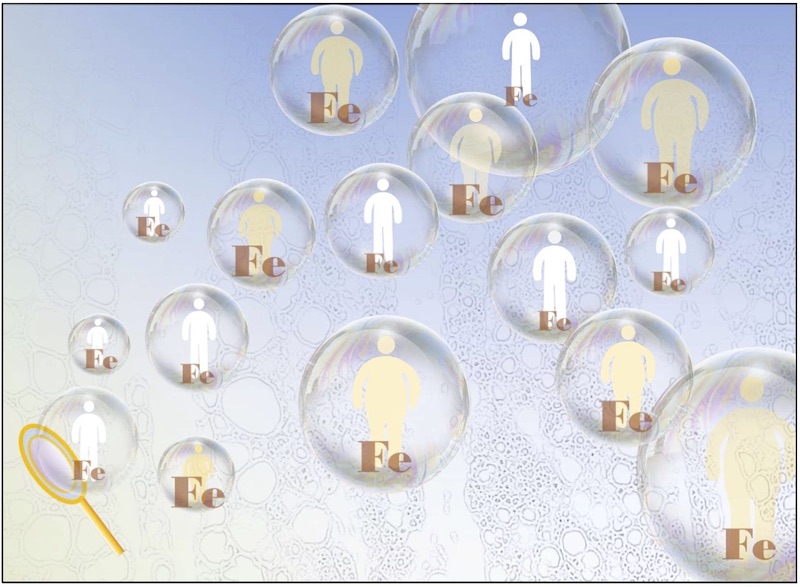COVID-19’s socio-economic effects will likely cause another severe production crisis in the coffee industry, according to a Rutgers University-led study.
Category: Research Results

Are We Missing Other Earths?
Some exoplanet searches could be missing nearly half of the Earth-sized planets around other stars. New findings from a team using the international Gemini Observatory and the WIYN 3.5-meter Telescope at Kitt Peak National Observatory suggest that Earth-sized worlds could be lurking undiscovered in binary star systems, hidden in the glare of their parent stars. As roughly half of all stars are in binary systems, this means that astronomers could be missing many Earth-sized worlds.
Mountaintop glacier ice disappearing in tropics around the world
Mountaintop glacier ice in the tropics of all four hemispheres covers significantly less area — in one case as much as 93% less — than it did just 50 years ago, a new study has found.
Pulling Wisdom Teeth Can Improve Long-Term Taste Function
Patients who had their wisdom teeth extracted had improved tasting abilities decades after having the surgery.

Lowering Iron in Fat Cells Prevented Weight Gain in Mice
DALLAS – June 28, 2021 – Lowering iron content in fat cells prevented mice fed a high-fat diet from gaining excess weight and developing associated health problems by limiting the amount of lipids absorbed by the intestines, UT Southwestern scientists report in a new study. The findings, published online in Cell Metabolism, could eventually lead to new strategies to protect people against obesity and related diseases.

UT Southwestern Investigators Report First Analysis Of Pioneering Kidney Cancer Radiation Approach in Clinical Trial
A new approach using precisely targeted, high-dose radiation to treat invasive kidney cancer proves safe, based on a clinical trial by the UT Southwestern Harold C. Simmons Comprehensive Cancer Center’s kidney cancer program. The study, published in the International Journal of Radiation Oncology*Biology*Physics, could offer new hope for patients with a historically dismal condition.
Unusual prey: Spiders eating snakes
There are spiders that eat snakes; observations of snake-eating spiders have been reported around the world. Two researchers from Basel and the US consolidated and analyzed over 300 reports of this unusual predation strategy
COVID-19 patients recover faster with metabolic activator treatment, study shows
Metabolic activators were found to reduce recovery time by as many as 3.5 days in patients with mild-to-moderate Covid-19, according to a Swedish-British study published today in Advanced Science.
Hackensack University Medical Center Breast Surgeons Demonstrate Accuracy of New Technology for Marking Location of Cancerous Lymph Nodes
Breast surgeons at Hackensack Meridian Hackensack University Medical Center have a new tool that allows them to pinpoint breast tumors more easily, with many benefits to the patient.
Love: How the feeling of power determines happy relationships
Want to have a happy relationship? Make sure both partners feel they can decide on issues that are important to them. Objective power measured by income, for example, doesn’t seem to play a big role, according to a new study in the “Journal of Social and Personal relationships” by the Martin Luther University Halle-Wittenberg (MLU) and the University of Bamberg.
Paleonursery offers rare, detailed glimpse at life 518 million years ago
Deposit contains exceptionally preserved fossils of soft-bodied, juvenile organisms from the Cambrian
Newly discovered sperm movement could help diagnose, treat male infertility
UToledo research shows the centriole’s role in sperm evolved from a shock absorber to a transmission system
Researchers develop world-first weight loss device
University of Otago, New Zealand, and UK researchers have developed a world-first weight-loss device to help fight the global obesity epidemic.
Researchers are using photos of toasters and fridges to train algorithms to detect COVID
New research using machine learning on images of everyday items is improving the accuracy and speed of detecting respiratory diseases, reducing the need for specialist medical expertise
‘Dragon man’ fossil may replace Neanderthals as our closest relative
A near-perfectly preserved ancient human fossil known as the Harbin cranium sits in the Geoscience Museum in Hebei GEO University. The largest of known Homo skulls, scientists now say this skull represents a newly discovered human species named Homo longi or “Dragon Man.” Their findings, appearing in three papers publishing June 25 in the journal The Innovation, suggest that the Homo longi lineage may be our closest relatives–and has the potential to reshape our understanding of human evolution.
Don’t worry, birds won’t become dependent on you feeding them, study suggests
Oregon State University researchers have some good news for the well-meaning masses who place bird feeders in their yards: The small songbirds who visit the feeders seem unlikely to develop an unhealthy reliance on them.
Angelenos versus New Yorkers: What do they talk about online?
A new novel computational social science tool detects similarities/differences of topics in online conversation
COVID-19 vaccine generates immune structures critical for lasting immunity
A new study from researchers at Washington University School of Medicine in St. Louis, published June 28 in the journal Nature, has found evidence that the immune response to Pfizer’s mRNA vaccine against COVID-19 is both strong and potentially long-lasting.
Can a calculator predict your risk of dementia?
Canadian researchers at The Ottawa Hospital, the University of Ottawa, the Bruyère Research Institute and ICES have built and validated an online calculator that empowers individuals 55 and over to better understand the health of their brain and how they can reduce their risk of being diagnosed with dementia in the next five years.
Mouse brain imaged from the microscopic to the macroscopic level
Researchers at the University of Chicago and the U.S. Department of Energy’s (DOE) Argonne National Laboratory have leveraged existing advanced X-ray microscopy techniques to bridge the gap between MRI (magnetic resonance imaging) and electron microscopy imaging, providing a viable pipeline for multiscale whole brain imaging within the same brain
U.S. presidents’ narcissism linked to international conflict
The most narcissistic U.S. presidents since 1897 preferred to instigate conflicts with other great power countries without seeking support from allies, a new study suggests.
CHOP Researchers Discover Unique Immune Response by Cells Critical to Lung Health
Researchers at Children’s Hospital of Philadelphia (CHOP) have discovered that a specific type of lung cell exhibits unconventional immune properties and may contribute to the outcome of respiratory viral infections. The researchers focused on type II alveolar (AT2) cells, which are non-immune cells of the lung that are critical for basic lung health and tissue repair after lung injury. They found that AT2 cells express high levels of major histocompatibility complex II (MHC-II), an important immune system trigger, and that AT2 MHC-II expression appears to confer an appreciable advantage in the outcome of respiratory viral infection. The findings were published today in Nature Communications.
People living with HIV/AIDS have a significantly higher risk of suicide
A new study by researchers at Penn State College of Medicine indicates that people living with human immunodeficiency virus (HIV) and acquired immune deficiency syndrome (AIDS) — approximately 38 million worldwide — are more likely to have suicidal thoughts and die from suicide than members of the general population.
Gene Variant Linked to Unnecessary Bone Marrow Biopsies in African Americans
A gene variant that lowers white blood cell levels and is common in individuals with African ancestry contributes to unnecessary bone marrow biopsies, according to a study published June 28 in JAMA Internal Medicine.
Understanding Black Youth Suicide: Steps Toward Prevention
In a statement published in JAMA Pediatrics, researchers at the Nationwide Children’s Hospital, the University of North Carolina at Chapel Hill and the nonprofit research institute RTI International responded to a call from the National Institute of Mental Health (NIMH) requesting information on how to prevent Black youth suicide. The researchers emphasize the need for research and action of suicide prevention among Black youth must start from the ground up.
Unique neuron can guide our way home by turning compasses into a gyroscope
Finding our way home from work or school is something most of us take for granted. Persons with Alzheimer’s disease, however, can get lost even when moving between such familiar locations and often struggle to find their way home.
Life could exist in the clouds of Jupiter but not Venus
Jupiter’s clouds have water conditions that would allow Earth-like life to exist, but this isn’t possible in Venus’ clouds, according to the groundbreaking finding of new research led by a Queen’s University Belfast scientist.
AI Learns to Predict Human Behavior from Videos
New Columbia Engineering study unveils a computer vision technique for giving machines a more intuitive sense for what will happen next by leveraging higher-level associations between people, animals, and objects.“Our algorithm is a step toward machines being able to make better predictions about human behavior, and thus better coordinate their actions with ours,” said Computer Science Professor Carl Vondrick. “Our results open a number of possibilities for human-robot collaboration, autonomous vehicles, and assistive technology.”
Mask-wearing reduces COVID-19 transmission, study finds
Mask-wearing is associated with a significant reduction in COVID-19 transmission and factors other than mandates contributed to the global uptake of mask-wearing in 2020, new research has found.
Sleep-deprived individuals less forthcoming with information about criminal history
It is common for investigators to interview suspects or witnesses who’ve had little sleep. While unavoidable in some cases, a new Iowa State University study found sleep disruption or deprivation may limit the amount of information provided during an interview.
Researchers engineer ‘natural killer’ cells that attack and destroy malignant tumour cells but leave the rest alone
Researchers at McMaster University have developed a promising new cancer immunotherapy that uses cancer-killing cells genetically engineered outside the body to find and destroy malignant tumours.
Response to COVID-19 Vaccines Varies Widely in Blood Cancer Patients
Patients with a type of blood cancer called multiple myeloma had a widely variable response to COVID-19 vaccines—in some cases, no detectable response—pointing to the need for antibody testing and precautions for these patients after vaccination, according to a study published in Cancer Cell in June.
National Poll: 1 in 4 parents worry that their infant or toddler is behind in developmental milestones
Nearly a quarter of parents have suspected their child might be delayed in their development, a new national poll finds – but they may not always share these concerns with a doctor.
Trauma Patients with COVID-19 Face Greater Risk of Complications and Death
COVID-19 complicated patient care in a range of ways, from increased incidence of heart attacks to decreased cancer screenings. The virus also caused a six-fold increase in the risk of complications and death among trauma patients, according to new research.
妙佑医疗国际(Mayo Clinic)的研究人员探索抗肥胖症的个性化用药方法
个体化医疗的创举主要专注于治疗罕见疾病或癌症。很少有人尝试对非传染性慢性疾病进行个体化治疗,例如肥胖症 — 这是一种慢性复发疾病,也是诱发2型糖尿病、脂肪肝病、心血管疾病和癌症的主要病因。有许多肥胖症干预的措施,例如饮食、辅助设备、手术和药物。然而,人们对这些肥胖症干预措施的反应预测因素知之甚少。
Backscatter Breakthrough Runs Near-Zero-Power IoT Communicators at 5G Speeds Everywhere
Researchers at the Georgia Institute of Technology, Nokia Bell Labs, and Heriot-Watt University have found a low-cost way for backscatter radios to support high-throughput communication and 5G-speed Gb/sec data transfer using only a single transistor.
Mayo Clinic researchers study potential new CAR-T cell therapy for multiple myeloma
Researchers at Mayo Clinic Cancer Center are studying a potential new chimeric antigen receptor-T cell therapy (CAR-T cell therapy) treatment for multiple myeloma. Their findings were published on Friday, June 24, in The Lancet.

Stronger corn stalks could lead to greater food security
Corn is one of the most important cereal crops in the world.
Loss of circadian regulation allows for increase in glucose production during lung cancer progression
New research from the University of California, Irvine reveals how the circadian regulation of glucose production in the liver is lost during lung cancer progression, and how the resulting increase in glucose production may fuel cancer cell growth.
Georgia Covid-19 Vaccine Dashboard Breaks Down Vaccination Trends by Race at County Level
A new Covid-19 vaccine dashboard for the state of Georgia shows vaccination rates among white residents are higher than those of Black residents in all large metro counties, as well as in around 70% of all Georgia counties.
Clemson Ag Service Lab contributes to Southern fertilizer study
Shannon Alford, director of the Agricultural Service Laboratory, joined colleagues from across the South to conduct a study of recommendations for phosphorus and potassium application on crops across the region.
Black Lives Matter Scholars are Set to Excel in Neuroscience and Neurosurgery
There is also the emerging understanding that overcoming systemic racism helps ensure that everyone has a chance to access advanced education and training.
To help drive this change, the Department of Neurological Surgery at the University of Miami Miller School of Medicine has established the Black Lives Matter Fellowship to support Black students who want to conduct advanced work in neuroscience or neurosurgery.
Study: Drug dosage for children could be improved with new method under development
A University at Buffalo-led team of researchers developed a mathematical equation that helps better simulate the impact of drug dosage on children by age, weight and sex.
Study confirms the low likelihood that SARS-CoV-2 on hospital surfaces is infectious
A new study confirms the low likelihood that coronavirus contamination on hospital surfaces is infectious. The study is the original report on recovering near-complete SARS-CoV-2 genome sequences directly from surface swabs.
Differences in human, mouse brain cells have important implications for disease research
A UCLA-led study comparing brain cells known as astrocytes in humans and mice found that mouse astrocytes are more resilient to oxidative stress, a damaging imbalance that is a mechanism behind many neurological disorders.
UC San Diego Scientists Develop the First CRISPR/Cas9-based Gene Drive in Plants
Researchers have created the first CRISPR-Cas9-based gene drive designed for plants. The new technology, which allows scientists to cut and copy key genetic elements, helps scientists breed plants that defend against crop diseases and withstand the impacts of climate change.
Antacids may improve blood sugar control in people with diabetes
Antacids improved blood sugar control in people with diabetes but had no effect on reducing the risk of diabetes in the general population, according to a new meta-analysis published in the Endocrine Society’s Journal of Clinical Endocrinology & Metabolism.
تنبيه من الخبراء: 4 فوائد لجراحة العمود الفقري الروبوتية
مدينة روتشستر، ولاية مينيسوتا- تسمح الجراحة الروبوتية، أو الجراحة بمساعدة الروبوت، للأطباء بإجراء العديد من الإجراءات المعقدة – منها ما يشمل العمود الفقري – بمزيد من الدقة والمرونة والتحكم بالمقارنة مع التقنيات التقليدية.
How Does Dengue Vaccines Fail to Protect Against Disease
UNC-Chapel Hill scientists investigated blood samples from children enrolled in a dengue vaccine trial to identify the specific kinds of antibody responses that correlate with protection against dengue virus disease.
A Key Player in Brain Development, Cell Communication Uncovered
For the first, time UNC School of Medicine scientist Katie Baldwin, PhD, and colleagues revealed a central role of the glial protein hepaCAM in building the brain and affecting brain function early in life.